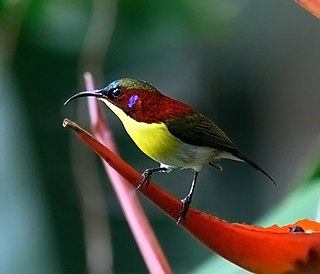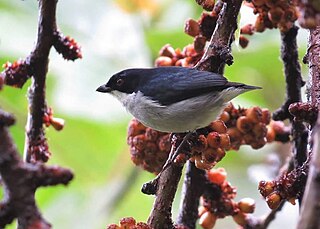
The thick-billed flowerpecker is a tiny bird in the flowerpecker group. They feed predominantly on fruits and are active birds that are mainly seen in the tops of trees in forests. It is a resident bird with a wide distribution across tropical southern Asia from India east to Indonesia and Timor with several populations recognized as subspecies some of which are sometimes treated as full species.

The handsome sunbird is a species of bird in the family Nectariniidae. It is endemic to the Philippines.

The lovely sunbird is a bird species in the family Nectariniidae. It is endemic to the Philippines. Its natural habitats are subtropical or tropical moist lowland forests and tropical moist montane forests.

The yellow-crowned flowerpecker is a species of bird in the family Dicaeidae. It is endemic to Luzon Island in the Philippines. It was formerly conspecific with the Flame-crowned flowerpecker of Mindanao. Its natural habitat is tropical moist montane forest. It is becoming rare due to habitat loss.

The red-keeled flowerpecker or red-striped flowerpecker is a species of bird in the family Dicaeidae. It is endemic to the Philippines. It is one of the more common birds in the Philippines as it is able to thrive in a wide array of habitats. The black-belted flowerpecker was formerly regarded as a subspecies of this bird.

The bicolored flowerpecker is a species of bird in the family Dicaeidae. It is endemic to the Philippines.

The black-belted flowerpecker or Visayan flowerpecker, is a species of bird in the family Dicaeidae. It is endemic to the Philippines where it is restricted to Panay, Negros and Guimaras islands. It was formerly regarded as a subspecies of the more widespread red-keeled flowerpecker. Sometimes the name red-keeled flowerpecker is used for D. haematostictum and D. australe is then known as the red-sided flowerpecker.

The buzzing flowerpecker or white-bellied flowerpecker is a species of bird in the family Dicaeidae. It is endemic to the Philippines. Its natural habitats are tropical moist lowland forest and or tropical moist montane forest.

The fire-breasted flowerpecker is a species of bird in the family Dicaeidae found in the Indian Subcontinent and Southeast Asia. Like other flowerpeckers, this tiny bird feeds on fruits and plays an important role in the dispersal of fruiting plants. Unlike many other species in the genus, this species has marked sexual dimorphism with the male having contrasting upper and lower parts with a distinctive bright orange breast patch. The female is dull coloured.

The olive-capped flowerpecker is a species of bird in the family Dicaeidae. It is endemic to the island of Mindanao in the Philippines.Its natural habitat is tropical moist montane forest.

The whiskered flowerpecker is a species of bird in the family Dicaeidae. It is endemic to the island of Mindanao in the Philippines. Its natural habitat is tropical moist montane forest. It is becoming rare due to habitat loss.

The pygmy flowerpecker is a species of bird in the family Dicaeidae. It is endemic to the Philippines.

The scarlet-collared flowerpecker is a species of bird in the family Dicaeidae, about 10cm long and is endemic to the Philippines where it found only in the tropical moist lowland forests in Mindoro, usually occurring below 1000m in the canopy and edge of the forest and in open country with scattered trees. Along with the critically endangered Cebu flowerpecker, it is one of the two threatened flowerpeckers in the Philippines and is declining primarily due to habitat loss.

The ashy flowerpecker is a species of bird in the family Dicaeidae. It is endemic to Indonesia where it occurs on Seram, Ambon and nearby islands in the Banda Arc. Its natural habitats are subtropical or tropical moist lowland forest and subtropical or tropical moist montane forest.

The Mindanao white-eye, also known as the black-masked white-eye, is a species of bird in the family Zosteropidae. The specific epithet honours British zoological collector Walter Goodfellow. It is endemic to the Philippines. Its natural habitat is subtropical or tropical moist montane forest.

The green-backed whistler or olive-backed whistler, is a species of bird in the family Pachycephalidae. It is endemic to the Philippines. Its natural habitats are tropical moist lowland forest and tropical moist montane forest.

The olive-backed flowerpecker is a species of bird in the family Dicaeidae. It is endemic to the Philippines. Its natural habitat is tropical moist lowland forest.

The sulphur-billed nuthatch is a species of bird in the family Sittidae. It is endemic to the Philippines. Its natural habitats are tropical moist lowland forest and tropical moist montane forest. It is commonly found in mixed flocks along with Blue-headed fantails, sunbirds, flowerpeckers and other small forest birds.

The flame-crowned flowerpecker is a species of bird in the family Dicaeidae. It is endemic to Mindanao in the Philippines. The yellow-crowned flowerpecker, which is endemic to Luzon, was formerly considered conspecific.

The fire-throated flowerpecker is a species of bird in the flowerpecker family Dicaeidae that is found in the Philippines except on the islands of Mindoro, the Palawan group and the Sulu Archipelago. It was formerly considered to be a subspecies of the fire-breasted flowerpecker.






















